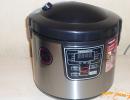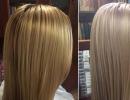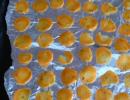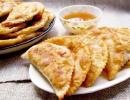Lingonberries for colds: recipes
One of the favorite plants of folk and traditional medicine is lingonberry. This is an evergreen shrub of the heather family. Grows in forest and tundra zones.
The berries of the plant are widely used in cooking due to their taste. The presence of vitamins and other active elements in them allows lingonberries to be used as a general tonic. Official medicine prefers to use leaves and shoots. Decoctions and infusions are made from them.
Composition and properties
Berries, leaves, and shoots of lingonberries contain many useful substances:
- Phenolglycosides.
- Tannins.
- Various organic acids (tartaric, citric, malic, etc.).
- Vaccinin.
- Arbutin.
- Flavonoids.
- Vitamins.
The elements in the composition have a bactericidal, tonic, diuretic and hypothetical effect. The presence of tannins allows you to use lingonberry juice topically, for example, for gargling.
Lingonberries are used in the treatment of colds and viral diseases, some kidney diseases, high blood pressure, vitamin deficiencies and anemia in pregnant women.
The cause of ARVI is viruses that cause general malaise, fever, and inflammation of the upper respiratory tract. In most cases, it is useless to fight the virus itself.
The main goal of therapy is to strengthen the immune system, alleviate the manifestation of the disease and minimize the risk of complications.
Recipes
In most cases, ARVI goes away within 10 days, but sometimes the disease takes a protracted course. In this case, you have to see a doctor and take medication. Lingonberries help fight complications when you have a cold. Its properties make it possible to prevent secondary bacterial infection. The diuretic effect accelerates the removal of toxins from the body. Vitamins and organic acids allow you to restore your protective potential as quickly as possible.
Most often, a recipe for colds contains lingonberries themselves. They have a pleasant taste, which is important when the medicine is given to children.
- Morse is the most popular recipe made from lingonberries for treating colds. For 1 glass of berries you need two glasses of water and 50 g of sugar. Place lingonberries in a container, add water and boil. After boiling, the fruit drink must be kept on low heat for 15 minutes. Cool the drink and strain. Drink 1 glass 3 times a day. The disadvantage of this recipe is heat treatment, since boiling destroys some beneficial substances.
- Lingonberry collection. For cooking, you can use all parts of the plant: branches, berries and leaves. All ingredients must be pre-dried and crushed, you can add strawberry leaves. For 2.5 cups of liquid - two tablespoons of the mixture. The mixture is poured with boiling water and left for 30 minutes. It is better to take with honey.
- Infusion of lingonberry leaves. For cooking you need lingonberry leaves and twigs. The raw materials must be crushed. For 1 glass of water, 1 tablespoon of chopped herbs is enough. Boil water and pour in lingonberries. You can take it after 30 minutes, after filtering it first. It is advisable to consume the infusion in an amount of 40 ml 5 times a day.
- Lingonberry tea. For 50 g of crushed lingonberry leaves - 500–600 ml of boiling water. You can add honey to improve the taste.
- Decoction. This recipe is a mixture of herbs. In addition to lingonberries, the decoction will include coltsfoot, anise, raspberry and linden flowers. The quantity of all components is 20 g. You can also add 10 g of lingonberry fruits. Pour the resulting mixture with 1.5 cups of boiling water. Then leave in a water bath for half an hour. It's good to drink hot before bed.
- Infusion of fruits. For preparation you need berries and water in a ratio of 1:2. The berries are poured with water and left for 6 hours.
- Lingonberry syrup. Mix lingonberry juice with honey or sugar in a 1:2 ratio. Take 1 tablespoon of syrup several times a day. For children, 3 times a day is enough.
- Juice with honey. Sort the berries and pass through a juicer. The resulting juice will have a distinct sour flavor. Honey will soften the acidity a little. For 100 ml of juice take a tablespoon of honey. Mix honey with juice and take orally 3-4 times a day. This recipe uses freshly squeezed juice. It is rich in vitamins and other useful substances, and is good for fever and runny nose. But the use of this remedy should be used with caution by people who have stomach diseases with high acidity, as well as increased tooth sensitivity. High concentrations of acids cause discomfort. It is more convenient to drink the juice through a straw, which is good for children. Babies love the sweet and sour taste and are willing to drink the right amount of liquid.
You can also eat candied berries, lingonberry candies, and lingonberry jam. When it comes to children, it is easier to convince a child to eat something if the product is sweet.
Colds in children

Benefits of lingonberries in treating children:
- Pleasant taste.
- Safety.
- Effectiveness.
With colds in children, as a rule, severe intoxication is observed. To reduce it, it is important to consume plenty of fluids. Children are not always willing to drink plain water. Lingonberry water, fruit drink or another recipe is a wonderful way to give your child something to drink. The pleasant taste forces you to drink a sufficient amount. In combination with the action of antioxidants and vitamins, lingonberry decoctions, syrups, and infusions help children well in the fight against infection.
It is best to take lingonberries before meals, as otherwise diarrhea may occur.
Contraindications
Despite a wide range of positive properties, the use of lingonberries is not indicated for everyone. The use of berry-based products is prohibited if the following diseases occur:
- High stomach acidity.
- Gastritis.
- Stomach ulcer.
- Inflammation of the gallbladder.
- Urolithiasis disease.
- Low pressure.
Care should be taken to give the product to babies under one year of age and only after consulting a doctor. Berries are contraindicated for infants due to the risk of allergic reactions. Be careful when trying only leaf decoctions.
Herbal treatment for colds is a safe and quite effective method. But if there are hints of complications (high temperature, rashes, cough), you should urgently consult a doctor and undergo additional examination.
Source: elaxsir.ru
How lingonberries are used for colds
In folk medicine, there are several recipes for using lingonberries for colds and typical respiratory diseases, including ARVI, bronchitis and sore throat. In all cases of such use, the antiseptic and astringent properties of lingonberries are used, providing some relief to the patient’s condition and protection against the spread of bacterial infection in the body.

Lingonberry leaves are mainly used as medicine. The berries are used more as a general tonic.
When used correctly, lingonberry preparations can slightly reduce the patient’s body temperature and enhance the effect of taking antipyretics. In addition, with their help you can increase the productivity of cough and speed up the expectoration of mucus from the bronchi.
Correctly performed gargling with lingonberries somewhat eases sore throats and allows you to shorten the duration of inflammation of the tonsils or pharyngeal mucosa.
An important advantage of lingonberry preparations is their safety. If you do not exceed the recommended doses and concentrations, then locally, without ingestion, such drugs can be prescribed to children, starting from school age. Children can take oral preparations based on lingonberry leaves from the age of 12, and drinks made from berries can be taken orally at almost any age.
In any case, any products with lingonberries can be used for colds only as additional ones, in combination with other drugs. Lingonberries are not suitable as the main treatment because they cannot affect the cause of the cold itself.
A decoction of lingonberry leaves is used as a medicine for colds. Various drinks and preparations made from lingonberry berries can only be considered as a general tonic and, to some extent, a preventive remedy. With their help, you can quench the thirst of a patient with a high body temperature, but it is unlikely that it will be possible to treat the disease itself.
Properties of lingonberries that are useful for colds
Lingonberries have at least three important properties, due to which they can alleviate the condition of a person suffering from a cold:
- Diuretic, ensuring rapid removal of excess fluid from the body, and with it many cell breakdown products and bacterial toxins. The result is a detoxification effect, which is manifested by a decrease in temperature and a general weakening of fever symptoms;
- Antiseptic, allowing to destroy bacteria located on the surface of the inflamed mucous membranes of the throat, nasopharynx or trachea;
- A disinfectant used to cleanse the surface of the tonsils and nasopharynx from pathological mucus and pus.
At the same time, all these effects do not radically improve the patient's condition.
Thus, due to the diuretic effect, only part of the toxins or cell breakdown products are eliminated, but the main inflammatory process in the respiratory tract proceeds with its normal intensity. Therefore, it will not be possible to completely “bring down” the temperature with lingonberry decoction - it only inhibits its growth to some extent and prolongs the effect of taking powerful antipyretics.

The main ability of fruit drink is to quench thirst and compensate for possible lack of vitamins.
In their properties, lingonberries are similar to cranberries, and therefore, for colds, the leaves and berries of these plants can be used in a similar way. It is not correct to say that one of them is definitely better and more effective.
Likewise, the antiseptic effect of lingonberry preparations cannot be compared in strength to the effect of systemic antibiotics. In fact, a remedy with lingonberries can only destroy those bacteria that are already on the surface of the mucous membranes. And since the main focus of inflammation is in the deep underlying tissues, such drugs cannot affect it.
Lingonberries are used for colds only in alternative, folk medicine. In official medicine, no lingonberry products are used to treat respiratory diseases.
However, it is important to understand that lingonberry helps both if you drink its decoction and if you apply its decoction topically - in the form of rinses. The effects of these methods of administration will vary, and therefore it will be most useful to combine them.

As a rule, in areas remote from the lingonberry growing area, its leaves are not sold by weight, but are sold in pharmacies in already packaged form.
Methods of using a decoction of lingonberry leaves for colds
In folk medicine for colds, lingonberry decoction is used in several ways:
- It is drunk to obtain a diuretic effect and eliminate metabolic products of pathogenic bacteria in the urine;
- Steam inhalations are performed over the decoction to treat the upper respiratory tract;
- Gargle with the cooled preparation and rinse the nose to disinfect the mucous membranes here.
Of these, taking the decoction orally and gargling are the safest measures. Inhalations are already fraught with scalding of the patient, and nasal rinses are safe enough only for people who know how to carry them out.

Practice shows that in terms of their effectiveness, lingonberry preparations for rinsing the nose or gargling differ little from decoctions of other herbs and even a simple saline solution.
All three methods provide certain therapeutic effects and can be used either individually or in combination in addition to the main treatment.
Taking the decoction orally
When lingonberry decoction is ingested, its biologically active components (primarily arbutin and free hydroquinone) cause irritation of the renal parenchyma and stimulate urination. If the patient drank a sufficient amount of liquid before taking lingonberries, the decoction ensures intensive removal of this liquid from the body along with various toxins released during the development of infection.
When taking lingonberry decoction as a diuretic (as well as raspberry syrup or tea as a diaphoretic), it is important to provide the body with moisture before taking it. If this is not done, the diuretic effect will lead to dehydration of the body, which will only worsen the patient’s condition.
In addition, due to its astringent components, lingonberry decoction strengthens the digestive tract and eliminates the symptoms of diarrhea, which often occurs with the flu or severe colds.

It is important to remember that a decoction or tea based on lingonberry leaves does not taste very pleasant, and in some patients it causes nausea and even vomiting.
At the same time, the use of such drugs internally does not have any effect on cough.
Drink 1 glass of the decoction 3 times a day before meals.
Gargling and nasal rinsing
Use lingonberry decoction to gargle and rinse your nose in the same way as with any other gargle - chamomile, sage, or simply saline solution. At the same time, it provides similar effects:
- Moisturizes the mucous membrane of the throat or nasal passages, preventing them from drying out and the formation of mucus crusts;
- Washes away some of the mucus and pus from the mucous membranes;
- Relieves sore throat due to pharyngitis and tonsillitis, relieves a runny nose.
Such procedures have virtually no anti-inflammatory or analgesic effect.
If gargling is relatively simple to carry out, then rinsing the nose is already a responsible procedure, during which the solution may enter the lower respiratory tract. Therefore, such rinsing must be carried out very carefully with preliminary training and an understanding of how to block the airways so that the broth flows into one nostril, flows out of the other, but does not fall into the throat.

Practice shows that when you have a cold, it is enough to rinse your nose with a simple saline solution and use lingonberries for drinking.
Both gargling and nasal rinsing are carried out 4-5 times a day, after meals and before bed. For one procedure, use a glass of decoction with a temperature of 40-45°C, the procedure itself lasts 2-3 minutes. It is not recommended to rinse and rinse more often and for longer, since too intense treatment slows down the regeneration of the inflamed mucous membrane.
Inhalations with lingonberry leaves
Inhalations with lingonberry decoction have approximately the same effect against the manifestations of a cold as rinsing the nose with it - the product destroys some of the bacteria located on the surface of the mucous membrane of the nasal passages, moisturizes the mucous membrane itself, cleanses it of impurities, thins thickening mucus and prevents the development of crusts in the nose.

Practice shows that when you have a cold, you almost never need to inhale with lingonberry preparations.
Inhalations can be used very limitedly for respiratory diseases. The fact is that only steam inhalations can be performed with lingonberry decoction. The use of this product in nebulizers, compressor and ultrasonic inhalers is prohibited according to the instructions for these devices themselves due to the risk of essential oils and small debris from the decoction getting into the lungs.
At the same time, steam inhalations are prohibited if there is a bacterial infection in the respiratory tract, since when the temperature rises here, bacteria multiply more intensively, that is, inhalations can even provoke an exacerbation of the disease. The cold itself is an acute rhinitis, caused in most cases by a bacterial infection that develops against the background of a severe weakening of the immune system due to hypothermia, viral infection, stress, and hypovitaminosis. That is, if you have a classic cold, you cannot take inhalations with lingonberry decoction.
The only acceptable case of inhalation with lingonberry decoction is a clearly diagnosed ARVI by a doctor without a bacterial complication. But with it, the need for such procedures is very insignificant, since lingonberries are not capable of affecting a viral infection. To some extent, the vapors of the decoction, entering the trachea, facilitate expectoration when coughing, but are not able to significantly alleviate the patient’s condition.
At the same time, there are numerous cases of boiling water being thrown onto people who were inhaled and causing them to get burns. This is especially dangerous because, due to the specific position of the container with the broth, it topples mainly onto the stomach and perineum. Therefore, such inhalations are prohibited for children, regardless of whether parents are present nearby - a pan of boiling water can tip over at the most unexpected moment.
Thus, in most cases, inhalations with lingonberries for a “cold” are carried out either in violation of the rules for such inhalations (if done for bacterial rhinitis), or simply as a distracting procedure (if done for ARVI). In both cases, it is more rational to replace them by simply rinsing the nose with lingonberry decoction.
Recipe for lingonberry decoction used for respiratory diseases
The decoction of lingonberry leaves itself is prepared as follows:
- In a metal container, a teaspoon of dry lingonberry leaves is poured with a glass of water;
- The mixture is brought to a boil, boil for 3 minutes;
- The broth is removed from the heat and cooled at room temperature to 45-50°C;
- The broth is diluted with another glass of warm, clean water.
In many cases, this recipe may be slightly different, but the effectiveness of the final drug remains approximately the same.

A 50 g bag of leaves will last about a week to a week and a half.
After this, the drink can be taken orally or used for local tissue treatment.
You can also take lingonberry tea for oral administration. To prepare it, dried leaves should be brewed in the same way as regular tea, steeped for the same time and drunk. It can be consumed with honey and sugar, various jams, including sea buckthorn and raspberry, which is very useful for colds.
How can you use berries and remedies for colds?
Juices, fruit drinks and compotes made from lingonberries are considered very effective in quenching thirst in patients with fever. On the most critical days, when a patient with a cold has a high temperature, such drinks should be given in parallel with antipyretics. As a result, this will provide a faster and longer-lasting temperature reduction.

In medicine (especially pediatrics), the term “drinking” a patient with a high temperature is widely used - when drinking a large amount of liquid, it is easier for the body to independently regulate body temperature.
Due to the content of a large amount of vitamins, natural juices and fruit drinks from lingonberries are very useful during the recovery period after a cold. Therefore, it is useful to drink them both during the treatment of the disease and after its completion. And in the future, if berries are available, they can be used to prevent hypovitaminosis and simply to improve health - in any case, they are more useful than simple sweet drinks and water. At this time, you can add other berries to drinks - blueberries, cranberries, viburnum. They can be prepared according to almost any recipe. It is only important that the drink contains natural berries.
For the same purpose, by the way, you can simply eat lingonberries after recovery. The benefits from its berries will be the same as from drinks, especially if you don’t have to boil them to prepare them - after all, when boiling, some of the beneficial substances disintegrate and some of the beneficial qualities of the berries are lost.
A few words about contraindications
Due to the pronounced diuretic effect of both leaf decoctions and lingonberry drinks, such drugs are undesirable for several categories of patients:
- Breastfeeding mothers - due to the removal of large amounts of fluid from the body, the amount of breast milk may decrease;
- Patients with kidney stones, in whom excessive kidney activity can lead to stone movement, blockage of the urinary tract and subsequent problems;
- Pregnant women.
A decoction of lingonberry leaves is contraindicated for children under 12 years of age, but drinks made from fresh berries can be consumed at any age.
As a result, lingonberry-based products can be used for colds in addition to the main treatment. When used correctly, they can alleviate the patient’s condition and reduce some of the symptoms of the disease. And during the rehabilitation period, they will support the rapid restoration of strength and performance.
Source: herbarix.ru
Using lingonberries for coughs
Lingonberry for cough is considered an excellent natural medicine due to its healing properties. . Lingonberry products are used primarily to treat dry cough.
- Medicinal properties of lingonberries
- Additional recommendations
- Contraindications

Medicinal properties of lingonberries
It contains a huge amount of useful vitamins and microelements: 
- Vitamins A, B, C, E, etc.
- Minerals (potassium, iron, magnesium, sodium, phosphorus, etc.).
- Tannins.
- Organic acids (citric, benzoic, malic, etc.).
Due to this composition, lingonberries are used to treat many diseases and ailments, including cough. Therapy with its help allows you to restore the patient’s health by strengthening his immune system. The patient’s cough goes away quickly, as lingonberries have a beneficial effect on the mucous membrane of the throat.
In folk medicine, not only lingonberry fruits, but also its leaves are used to relieve cough. They have anti-inflammatory, antimicrobial and immunomodulatory properties.
Recipes for cough from lingonberry fruits
There are several ways to use lingonberries for coughs. In most cases, people use the berries of the plant to treat this ailment. Despite the slight bitterness, they have a fairly pleasant taste.
To preserve the beneficial properties of lingonberry fruits, just fill them with water and place them in the basement or refrigerator. When they are infused in water for several days, lingonberry juice is obtained, which can be used to gargle. It is used not only for irrigation, but also for internal use. This is an excellent method of combating sore throat.

Recipe with lingonberry syrup. One spoon of syrup must be dissolved in hot water. Then everything is stirred. Syrup diluted with water is drunk throughout the day. You need to drink it 2-3 times. Thanks to this medicine, the mucous membrane of the throat softens, and spasm of the respiratory tract is relieved.
Berry juice. Lingonberry juice should be mixed with honey. The amount of liquid should be proportional to the amount of honey. This medicine stimulates the passage of mucus and phlegm from the throat. It is taken 4 times a day.
Honey lingonberry juice. The lingonberries are moved and washed. After this, the berries need to be squeezed through a juicer. The resulting juice must be mixed with liquid honey in the same amount. This tasty product is drunk within 24 hours. Its main property is to alleviate dry cough.
Lingonberry juice is one of the best natural medicines for many ailments, since during its preparation it is possible to preserve the maximum amount of the medicinal properties of the berries. To achieve this, it is important to minimize the heat treatment of lingonberry fruits. There is no need to cook them, just pour boiling water over them.
 Before pouring hot water over the fruits, they must be sorted.
Before pouring hot water over the fruits, they must be sorted.
To prepare fruit juice, the fruits must first be softened. Next, they are poured with boiling water and infused. Before leaving the container with the fruit drink to infuse, it needs to be insulated.
Before consuming this natural medicine, it must be strained. To improve the taste, you should add granulated sugar or honey to the fruit drink.
This drug not only helps eliminate the problem of expectoration, but also strengthens the immune system. It is used to saturate the body with useful substances and reduce intoxication.
Recipes using lingonberry leaves
Remedies from lingonberries can be obtained not only through the use of berries. In folk medicine, it is customary to use the leaves of this plant to relieve spastic cough exhalations. You can buy them at any pharmacy.
Recipe for a healing decoction. Two spoons of leaves are poured into a glass of boiling water. The container in which they will be cooked must be covered with a lid. Cook the leaves for 30–35 minutes. Then they are removed from the boiling water and wrung out. A few tablespoons of mineral water should be added to the resulting decoction. It should be taken before bed, 5 tablespoons. It is not recommended to prepare large quantities of this decoction, since the shelf life is no more than 2 days.

Warming compress. In order to make a heat compress, you must first prepare a decoction of the leaves, as in the previous recipe. It involves adding honey. It is advisable that there be 2 times more honey than liquid. Then take gauze and soak it in the prepared mixture. The application should be placed on the patient's chest. It is recommended to insulate the human body with a woolen scarf or sweater. This compress should be kept for 2 hours.

Lingonberry tea recipe. This is the easiest way to prepare a potion using the healing leaves of this berry. To make this tea, you just need to pour boiling water over them and leave for 15–20 minutes. To improve the taste of the drink, you should add a spoonful of honey to it. Healing tea is drunk throughout the day.

Lingonberries for flu and fever
In folk medicine, this berry has been used for many years to treat influenza and colds. With its help, it is possible to reduce body temperature.
 Infusion of lingonberry branches. Dried leafy branches are poured with boiling water. One spoon of raw material is poured into a glass of hot water. The resulting mixture should infuse. It is recommended to infuse the twigs in a thermos. After 1 hour, the infusion should be taken 2 tablespoons throughout the day.
Infusion of lingonberry branches. Dried leafy branches are poured with boiling water. One spoon of raw material is poured into a glass of hot water. The resulting mixture should infuse. It is recommended to infuse the twigs in a thermos. After 1 hour, the infusion should be taken 2 tablespoons throughout the day.
Healing collection. To fight the flu, it is recommended to use a collection of this plant, consisting of its different parts. In your home medicine cabinet it is useful to have not only lingonberry fruits, but also its branches and leaves . To prepare the medicine, it is important to mix all 3 healing elements of the plant and pour hot water over them. They must be infused for at least 1 hour in a thermos. When the mixture has cooled, add honey to it.
The use of lingonberries for the treatment of colds in childhood
A child's cough is always a cause of great concern for parents. This therapy is excellent for combating flu and colds in young patients.

Any traditional method that does not contain alcohol can be used for medicinal purposes. Parents of a sick child need to remember the rule - in order to prepare a folk medicine from lingonberries for their child, the dosage of each of the ingredients used should be reduced.
These recipes help not only reduce the baby’s body temperature, but also strengthen his immune system. With their help, the body is saturated with beneficial microelements. This promotes faster recovery.
Infants with a cold should be treated with lingonberry leaf decoction. To help your baby feel better, it is enough to give him 1 spoon of this decoction three times a day.
As for older children (7–13 years old), they can be given lingonberry juice or fruit drink to fight a cold. And lingonberry fruits are considered an excellent substance for stimulating appetite.
Contraindications
Lingonberry is one of the safest natural medicines. Recipes for its preparation help even pregnant and breastfeeding women get rid of the disease. But the funds have a number of contraindications. Their list is small, but some categories of people need to familiarize themselves with them before using this remedy for medicinal purposes.
- Urolithiasis disease.
- Stomach or duodenal ulcer.
- Postoperative period.
- Increased blood pressure (hypertension).
- Diseases of the gastrointestinal tract (cholecystitis).
- The presence of individual intolerance.





Doctors do not advise treating any disease with the help of this plant to patients suffering from kidney failure and those who have kidney stones.
Treatment of sore throat and bronchitis with lingonberry

You should not assume that traditional medicine is a complete therapy that allows you to cope with bronchitis and sore throat. The use of lingonberry fruits, leaves and branches should become an auxiliary therapeutic method. In order to get rid of colds or viral diseases, the patient must take medications aimed at strengthening his immune system.
To get rid of sore throat with the help of this plant, you need to make a solution for rinsing the mouth from it. Thanks to the beneficial properties of this berry, the patient’s discomfort in the throat quickly disappears.
If bronchitis is accompanied by a cough, the patient is recommended to use fresh or dried elements of the plant. The recipe can be anything, for example, you can make syrup, fruit drink, decoction or infusion. To enhance the effectiveness of one of these products, it is recommended to include cranberries in its composition.






